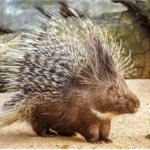Paper, Axial compression of a hollow cylinder filled with foam: A study of porcupine quills
The following paper explores the quill properties and structures of the Hystrix(Old World) and Erethizon(New World) porcupines. Both quills have a keratinous cortex filled with closed cell foam, that have good tensile strength, extensive deformation properties, and compressive capabilities. The main difference between the quills is the presence of stiffeners inside of the foam that exist in Hystrix and not in Erethizon. Hystrix quills have longitudinal stiffeners attached to the cortex surface with irregular scales that extend towards the center, with cells in the center of the quills larger than those of the cortex. The Erethizon quills have regular scales that decrease to a distal point as compared to Hystrix quills (reflected in the differing of sizes between the quills and thus their differences in flaring out and softening impacts from predators).
Learn about our two Decals!
 Click here to find out more about our Fall Bioinspired Design Decal and our Spring Bioinspired Design in Action Decal – ALL MAJORS are welcome.
Click here to find out more about our Fall Bioinspired Design Decal and our Spring Bioinspired Design in Action Decal – ALL MAJORS are welcome.Berkeley BioDesign Community
 Click here to learn about the BioD: Bio-Inspired Design @ Berkeley student organization or here to signup for more info.
Click here to learn about the BioD: Bio-Inspired Design @ Berkeley student organization or here to signup for more info.Search
Student Login




I imagine that the neurological circuits underlying these processes are governed by both 2d spacing maps with their brains as…
to reduce the impact of car accidents, it may be possible to study the force diverting physics of cockroaches to…
you see this type of head-bobbing stability in many avian creatures related to pigeons like chickens. the head ability to…
not like they taught horses how to run! this is an example of convergent evolution where both sea creatures and…
The brain functions in a similar way with neuronal connections. our brains are able to utilize the multiplicity of connections…